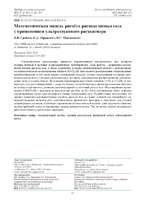| dc.contributor.author | Гребнев, В. П. | |
| dc.contributor.author | Абрамович, Н. Д. | |
| dc.contributor.author | Максимович, И. С. | |
| dc.coverage.spatial | Минск | ru |
| dc.date.accessioned | 2025-10-03T10:25:56Z | |
| dc.date.available | 2025-10-03T10:25:56Z | |
| dc.date.issued | 2025 | |
| dc.identifier.citation | Гребнев, В. П. Математическая модель расчёта расхода потока газа с применением ультразвукового расходомера = Mathematical Model for Calculating Gas Flow Using an Ultrasonic Flow Meter / В. П. Гребнев, Н. Д. Абрамович, И. С. Максимович // Приборы и методы измерений. – 2025. – № 3. – С. 265-274. | ru |
| dc.identifier.uri | https://rep.bntu.by/handle/data/158807 | |
| dc.description.abstract | Ультразвуковые расходомеры являются перспективным инструментом для контроля газовых потоков в бытовых и промышленных трубопроводах. Цель работы – разработка методологий расчёта расхода газа, а также разработка и анализ математической модели с использованием математического моделирования в пакете MATLAB для соосного расположения ультразвуковых преобразователей, в том числе анализ ограничений подхода. Основу исследования составила математическая модель с соосным расположением датчиков, описывающая распространение ультразвуковых волн в газовом потоке. Исходными параметрами выступили давление (5 Па и 8,5 кПа) и температура газа, рассчитываемыми – скорость потока, число Рейнольдса, время прохождения импульса по потоку и против него, разность указанных времён и итоговый расход газа. Моделирование проводилось в MATLAB с акцентом на методологию расчёта, но без учёта акустических помех и формы ультразвукового пучка (рассматривался только центральный луч). Разработанная методология позволяет проводить предварительные расчёты расхода газа и служит основой для дальнейшего совершенствования, включая учёт дополнительных физических факторов и адаптацию для угловой конфигурации датчиков. Ключевые ограничения математической модели: учёт звукового давления, шумов приёмной схемы и упрощенная модель волнового пучка. Тем не менее, модель подтвердила работоспособность для базовых сценариев. | ru |
| dc.language.iso | ru | ru |
| dc.publisher | БНТУ | ru |
| dc.title | Математическая модель расчёта расхода потока газа с применением ультразвукового расходомера | ru |
| dc.title.alternative | Mathematical Model for Calculating Gas Flow Using an Ultrasonic Flow Meter | ru |
| dc.type | Article | ru |
| dc.identifier.doi | 10.21122/2220-9506-2025-16-3-265-274 | |
| local.description.annotation | Ultrasonic flow meters are promising tool for monitoring gas flows in domestic and industrial pipelines. The aim of this work was to develop methodologies for calculating gas flow rate, as well as to develop and analyze a mathematical model using simulation in the MATLAB package for a coaxial arrangement of ultrasonic transducers, including an analysis of limitations of this approach. The base of the study was a mathematical model with a coaxial sensor arrangement, describing the propagation of ultrasonic waves in a gas flow. Input parameters were gas pressure (5 Pa and 8.5 kPa) and temperature, while the calculated parameters were flow velocity, Reynolds number, pulse transit time along and opposite the flow, difference between these two time values, and the final flow rate. The simulation was performed in MATLAB with a focus on the calculation methodology although without accounting for acoustic interference and the ultrasonic beam shape (only the central beam’s part was considered). The developed methodology allows for preliminary gas flow rate calculations and serves as a basis for further improvement including consideration of additional physical factors and adaptation for an angular transducer configuration. Key limitations of the mathematical model include: the omission of sound pressure, noise from the receiver circuit, and a simplified wave beam model. Nevertheless, the model confirmed its viability for basic scenarios. | ru |

